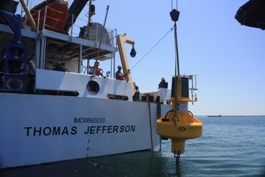News
"First Landing" CBIBS Buoy Deployed at Mouth of Bay
 Boaters and fishermen have a new way to check conditions at the mouth of the Chesapeake Ba
Boaters and fishermen have a new way to check conditions at the mouth of the Chesapeake Ba
CBIBS Tracks Upper Bay's Record-Low Salinity
The upper Chesapeake Bay experienced record-low salinity levels following near-record discharge from the Susquehanna River this spring.
Susquehanna, Patapsco Redeployed
Good news for buoy data users! The Susquehanna and Patapsco CBIBS buoys have been redeployed for the summer season and are once again reporting data from their locations off Havre de Grace, Maryland, near Susquehanna Flats and at the mouth of the Patapsco River near Baltimore.
Buoy System Updates
Buoy updates: The Upper Potomac and Potomac/Point Lookout buoys are back on station and reporting data. The Annapolis buoy's computer received an update and should be reporting extreme (high and low) wind speeds more accurately.
Buoy Redeployments on Temporary Hold
Early spring is usually when the CBIBS buoys that have been pulled for the winter (to avoid ice damage) are redeployed. But this year, for now, NOAA has put these redeployments—and the planned deployment of a new tenth buoy at the mouth of the Bay—on hold.
The CBIBS Scientist Is In!
Near Washington, D.C., and want to talk buoys and other observing systems? Join CBIBS project manager Doug Wilson in the "Scientist Is In" program at the Smithsonian's Sant Ocean Hall this Wednesday, April 20, 1-3 p.m.
Drop in Water Temps to Blame for Fish Kill?
Roughly 2 million fish have turned up dead in the middle part of the Bay, and state of Maryland scientists are investigating. Their working theory is that the fish died due to cold water stress.
Buoys Go on Winter Vacation
CBIBS buoys are built to withstand high winds and big waves—but some forces of nature are too much for the sensors attached to the buoys. Ice can damage these sensors, and large ice floes can even "relocate" buoys.
Gooses Reef Bottom Sensor Now Reporting Data
The Dominion Gooses Reef CBIBS buoy is the first location in the system to also include the capability to monitor water quality at the Bay bottom.


